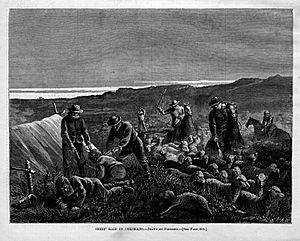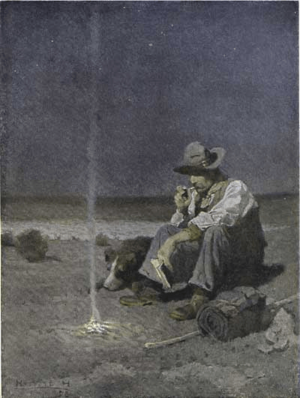Sheep Wars facts for kids
| Part of the Range Wars | |

Sheep Raid in Colorado, by Harper's Weekly.
|
|
| Date | c. 1870–1920 |
|---|---|
| Location | Western United States |
| Deaths | ~54 |
The Sheep Wars were a series of conflicts in the Western United States. These fights happened between sheep herders and cattle ranchers over who could use the land for their animals.
These "wars" took place in many western states. They were most common in Texas, Arizona, and the border area of Wyoming and Colorado. Cattle ranchers often saw sheep herders as invaders. They felt the sheep ruined the public grazing land that everyone shared.
From about 1870 to 1920, there were around 120 fights in eight different states or territories. At least 54 people died, and between 50,000 and 100,000 sheep were killed.
Contents
History of the Sheep Wars
Texas Conflicts
By 1870, Texas was already well-known for cattle ranching. Sheep herding was just starting to become popular in other parts of the Old West. Many cattle ranchers had strong connections with local government leaders. They used this influence to their advantage.
One historian noted that in court, cattle ranchers usually won. Sheep herders were often seen as weaker. They believed in "free grazing" on public land. Cattle ranchers, however, often built fences around land, whether it was public or private. Fences helped mark boundaries and stop animal theft. They also kept other people from grazing their animals there. Another concern was sheep scab, a disease that could spread to sheep.
Building fences made sheep herders and even some open-range cattlemen very angry. This led to conflicts like the Fence Cutting War. Also, many sheep herders were Hispanic or Native American, and this sometimes added to the tension.
One of the first sheep wars happened in 1875. It was on Charles Goodnight's ranch near the Texas-New Mexico border. Later, other sheep wars occurred in central and West Texas counties. These included Schleicher, Nolan, Brown, Crane, Tom Green, San Saba, and Coleman.
In 1881, Texas passed a law to inspect sheep for sheep scab. This law, however, just made herders hide their infected sheep. Other laws tried to stop sheep herders from using public land entirely. But these laws were hard to enforce.
In 1883, a new law required herders to show a health certificate for their sheep before crossing county lines. Cutting fences became a serious crime in 1884. Around this time, West Texas saw a "land rush." This meant many sheep and cattle ranchers lost access to public land. Sometimes, herders had to cut fences to reach public land. Eventually, a rule developed: herders had to move their sheep at least five miles a day on flat land, or three miles a day in rough areas, when crossing private property. Compared to other states, the violence in Texas sheep wars was not as bad.
Arizona's Violent Feuds
The Pleasant Valley War in Arizona was one of the most costly range wars in American history. It was a fight between the families of John D. Tewksbury and Tom Graham. Both families were cattle ranchers. However, the Tewksburys supported sheep herders when they came into Pleasant Valley in 1885.
The sudden arrival of many sheep on land used only by cattle made cowboys uneasy. They began to work together to protect their grazing areas. By 1886, it was illegal for sheep herders to bring their animals within two miles of cattle land. The Mogollon Rim became an unofficial border. No sheep were allowed south of it.
Pleasant Valley was south of this border. So, when the Daggs Brothers and the Tewksburys started bringing in sheep, local cattle ranchers like the Grahams fought back. The Grahams and Tewksburys had been feuding since 1882. The first death related to the sheep wars happened in 1885. A Basque sheep herder, hired by the Tewksburys, was killed while driving sheep into Pleasant Valley. Andy Cooper, a member of the Graham group, was believed to be responsible.
Another incident happened in February 1887. A Ute shepherd was killed while driving sheep near the Graham Ranches. Tom Graham was thought to be responsible, though he was never charged. The United States Army even sent Indian scouts to track the killer. Their tracks led to Tom Graham's cabin.
The conflict grew into a gunfight at the Middleton Ranch in August 1887. The ranch owner, George Newton, was a friend of the Tewksburys. Members of the Graham group, including some Hashknife cowboys, were looking for Mart Blevins. They thought the Tewksburys knew where he was. The Graham group had five men, led by Hampton Blevins. The Tewksburys had six men at the ranch.
Accounts differ on who shot first. But Hampton Blevins and John Payne from the Graham group were killed. Two others were wounded. This was a clear loss for the Graham side. After this, the war became a long series of revenge killings. It had less to do with sheep. By the time the war ended in 1892, about twenty-five people had died. This included all the men in the Graham family and most of the Blevins and Tewksbury families.
Other sheep wars happened in Arizona too. In 1884, near San Francisco Mountain, angry cattlemen gathered over 100 wild horses. They tied cowbells to their necks and rawhide to their tails. Then they drove the horses into sheep herds of more than 25,000, yelling and firing guns. The sheep scattered, many were killed or hurt. It took a week to gather the surviving animals. That same year, cowboys drove over 4,000 sheep into the Little Colorado River. Many died in quicksand.
Wyoming and Colorado Battles
The sheep wars in Wyoming and Colorado were very violent. They continued well into the 1900s. Like in Texas and Arizona, Colorado cattlemen did not want to share their pastures. Sheep herders were coming into the state from southern Wyoming.
In Wyoming alone, there were about twenty-four attacks and at least six deaths between 1879 and 1909. Some reports say over sixteen people were killed. The most famous conflict was the Routt County Sheep War. Cattlemen in Routt County, Colorado, tried to stop Wyoming sheep herders from entering their grazing lands.
In May 1895, the Cheyenne Leader newspaper reported that cattlemen were gathering. They wanted to stop sheepmen from crossing into their areas. About 350 cattlemen met to plan action. They decided to ban all sheep herders from northwestern Colorado. The newspaper warned that a "war is imminent." It said that 800 to 1,000 cattlemen were ready to fight. The sheep causing the trouble were about 60,000 owned by J. G. and G.W. Edwards and others from Wyoming.
Most sheep herders respected the cattlemen's decision, which helped calm the situation. However, there were at least four violent events in the region. The first was in 1894, in Garfield County. About 3,800 sheep were driven off cliffs into Parachute Creek. The herder, Carl Brown, was shot in the hip trying to stop them. A posse from Parachute found Brown wounded and many dead sheep. About 1,500 more sheep were killed in the same county that year.
In June 1896, Jack Edwards of Wyoming reported that two of his sheep herders were killed by Colorado cowboys. About 300 of his sheep were also killed. When Edwards went to the scene, masked men stopped him. They ordered him to take his remaining sheep back across the border.
On January 23, 1897, Edwards told a reporter that he had "about fifty [men] ready for the clash." He said he had to keep a "small army" to protect his property. He mentioned that 300 sheep and two herders had been killed recently. He said there were "several graves in the vicinity of Meeker" showing how serious the fights were.
Another attack happened on November 15, 1899. Forty masked men attacked a sheep camp on the lower Snake River. They "clubbed and scattered" over 3,000 sheep. The shepherds were robbed, and their wagon was burned.
Some of the most serious attacks outside of northwestern Colorado happened in 1887, 1896, 1902, 1905, and 1909. In 1887, nearly 2,600 sheep belonging to Charles Herbert died. Cowboys burned his corrals at Tie Siding, Wyoming. In 1896, about 12,000 sheep were killed in one night. They were driven off a cliff near North Rock Springs, Wyoming.
The violence became even worse after 1900. In 1902, near Thermopolis, Wyoming, thousands of sheep were killed, and their herders died. In the summer of 1905, ten masked men attacked a sheep camp on Shell Creek in the Big Horn Basin. They clubbed about 4,000 out of 7,000 sheep. They also burned the wagons and two sheep dogs. The owner, Louis A. Gantz, lost about $40,000.
The most serious attack was the Spring Creek Raid on April 2, 1909. Southwest of Ten Sleep, Wyoming, the sheep herder Joe Allemand and two friends were shot and killed by masked men. The attackers also killed about twenty-five sheep and two dogs. They burned the wagons with kerosene.
Before this, sheep raiders had never been punished in Wyoming courts. Many thought the killers would get away with it. However, seven men were arrested, and five went to prison. This conviction brought peace to Big Horn County. After 1909, cattlemen were less likely to raid sheep camps because they could now be punished.
There were two more sheep raids in Wyoming in 1911 and 1912, but no more herders were killed. The last known sheep raid in Colorado was in 1920. In that incident, 150 sheep were killed for grazing in the White River National Forest.
According to author Robert Elman, the sheep wars ended for several reasons. The amount of open grazing land decreased. Also, ranching methods changed, which removed many reasons for the fights. The Taylor Grazing Act of 1934 also helped reduce the tension.


